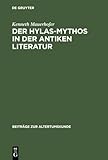Der Hylas-Mythos in der antiken Literatur / Kenneth Mauerhofer.
Material type: TextSeries: Beiträge zur Altertumskunde ; 208Publisher: Leipzig : B. G. Teubner, [2012]Copyright date: ©2004Edition: Reprint 2012Description: 1 online resource (485 p.)Content type:
TextSeries: Beiträge zur Altertumskunde ; 208Publisher: Leipzig : B. G. Teubner, [2012]Copyright date: ©2004Edition: Reprint 2012Description: 1 online resource (485 p.)Content type: - 9783598778209
- 9783110944433
- BL820.H96 M28 2004eb
- online - DeGruyter
- Issued also in print.
| Item type | Current library | Call number | URL | Status | Notes | Barcode | |
|---|---|---|---|---|---|---|---|
 eBook
eBook
|
Biblioteca "Angelicum" Pont. Univ. S.Tommaso d'Aquino Nuvola online | online - DeGruyter (Browse shelf(Opens below)) | Online access | Not for loan (Accesso limitato) | Accesso per gli utenti autorizzati / Access for authorized users | (dgr)9783110944433 |
Browsing Biblioteca "Angelicum" Pont. Univ. S.Tommaso d'Aquino shelves, Shelving location: Nuvola online Close shelf browser (Hides shelf browser)
Frontmatter -- VORWORT -- INHALTSVERZEICHNIS -- EINLEITUNG -- I. VERSCHOLLENE DARSTELLUNGEN DER HYLAS-SAGE -- II. DAS HYLAS-GEDICHT THEOKRITS (ID. 13) -- III. DIE HYLAS-EPISODE BEI APOLLONIOS RHODIOS (1,1153–1362) -- IV. APOLLONIOS ODER THEOKRIT? DIE PRIORITÄTSFRAGE -- V. DAS HYLAS-GEDICHT NIKANDERS (ANT. LIB. MET. 26) -- VI. DAS HYLAS-GEDICHT DES PROPERZ (1,20) -- VII. DIE HYLAS-EPISODE BEI VALERIUS FLACCUS (3,459–4,81 [89]) -- VIII. DIE HYLAS-EPIGRAMME DES AUSONIUS (EPIGR. 97–98 RIESE) -- IX. DIE HYLAS-EPISODE DER ORPHISCHEN ARGONAUTIKA (629–657) -- X. DAS HYLAS-GEDICHT DES DRACONTIUS (ROMUL. 2) -- XI. DAS ANONYME HYLAS-EPIGRAMM DES CODEX SALMASIANUS (ANTH. LAT. 69 RIESE = 57 SHACKLETON BAILEY) -- XII. SCHLUSSBETRACHTUNG -- ANHANG 2: METRISCHE ANALYSEN. VALERIUS FLACCUS, DRACONTIUS -- LITERATURVERZEICHNIS -- REGISTER
restricted access online access with authorization star
http://purl.org/coar/access_right/c_16ec
Herakles nimmt den schönen Jüngling Hylas, seinen Zögling und Geliebten, auf die Argonauten-Expedition mit, verliert ihn aber bei einem Zwischenhalt an eine oder mehrere Quellnymphen, die ihn auf den ersten Blick begehren. Herakles sucht ihn vergeblich. Das ist der Kern der Sage, die spätestens vom Hellenismus bis in die Spätantike beliebt war und von namhaften Dichtern immer wieder neu gestaltet wurde (u.a. Theokrit, Apollonios Rhodios, Nikander, Properz, Valerius Flaccus, Ausonius und Dracontius). Die vorliegende Arbeit erörtert die Möglichkeit verlorener Dichtungen und untersucht die erhaltenen Hylas-Texte sprachlich-inhaltlich, strukturell und intertextuell, wobei sie auch Prioritätsfragen behandelt. [Anhang 1: die Hylas-Texte. Anhang 2: Metrische Analysen (Valerius, Dracontius). Stellen-, Namen- und Sachregister.]
On the Argonauts' expedition, Heracles is accompanied by his beloved friend, the beautiful, young Hylas, until, during a stopover, he loses him to one or more fountain nymphs, who lust for him at first sight. Heracles' subsequent efforts to find him are in vain. This myth was popular from at least hellenistic times until late antiquity and therefore served several famous authors (Theocritus, Apollonius Rhodius, Nicander, Propertius, Valerius Flaccus, Ausonius and Dracontius) as a welcome subject. The study first considers hints at possibly lost representations of the story, then explores the transmitted texts in their narrative, stylistical, structural and intertextual aspects. It also addresses questions of priority. Appendix 1: The Hylas-texts. Appendix 2: Metrical analyses (Valerius, Dracontius). Indexes of passages, names and topics.
Issued also in print.
Mode of access: Internet via World Wide Web.
In German.
Description based on online resource; title from PDF title page (publisher's Web site, viewed 28. Feb 2023)









